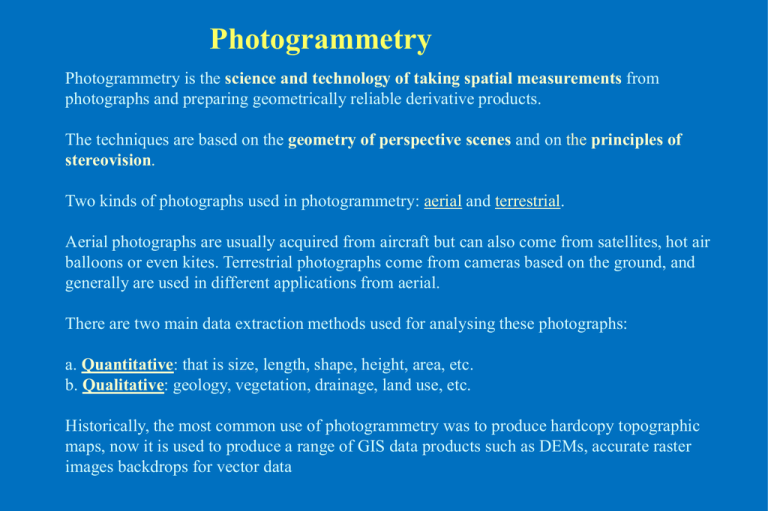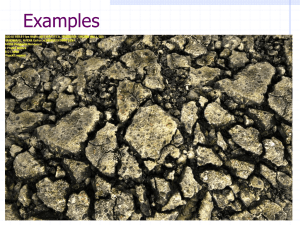lecture-7 Photogrametry
advertisement

Photogrammetry Photogrammetry is the science and technology of taking spatial measurements from photographs and preparing geometrically reliable derivative products. The techniques are based on the geometry of perspective scenes and on the principles of stereovision. Two kinds of photographs used in photogrammetry: aerial and terrestrial. Aerial photographs are usually acquired from aircraft but can also come from satellites, hot air balloons or even kites. Terrestrial photographs come from cameras based on the ground, and generally are used in different applications from aerial. There are two main data extraction methods used for analysing these photographs: a. Quantitative: that is size, length, shape, height, area, etc. b. Qualitative: geology, vegetation, drainage, land use, etc. Historically, the most common use of photogrammetry was to produce hardcopy topographic maps, now it is used to produce a range of GIS data products such as DEMs, accurate raster images backdrops for vector data Aerial photographs - Vertical - Oblique Vertical photographs most commonly used, but true vertical photographs are rare because of the angular attitude of the aircraft at the time of photography. This results in slight (1-3º) unintended inclination of the optic axis of the camera, resulting in titled photographs. However, for most practical applications, such photographs can be considered vertical photographs. Aerial photographs Aerial photographs Aerial photographs: Some terminology Fiducial marks Fiducial axis Fiducial marks - Index marks, usually 4, at the center point of each side of an air negative or photo. These are rigidly connected with the camera lens through the camera body— which forms images on the negative. Usually are a hairline, a cross, or a half-arrowhead. Edge of format Lens Nadir Principal Point - optical or geometric center of the photograph - the intersection between the projection of the optical axis (i.e., the perpendicular to the center of the lens) and the ground. Can be located by the intersection of lines between opposite side/corner fiducial marks. Plumb line Nadir - The nadir, also called vertical point or plumb point, is the image of the intersection between the plumb line Y axis Principal point directly beneath the camera center at the time of exposure and the ground. The nadir is important because relief displacement is radial from this point and is a function of the distance of the displaced image from it. Unlike the principal point, there are no marks on the photograph that permit to X axis locate the nadir. Isocenter Isocenter - The point on the photo that falls on a line halfway between the principal point and the Nadir point. Aerial photographs Determination of nadir in oblique photos Relief displacement is radial from nadir, and is a function of the distance of the displaced image from it. Nadir Isocentre Principal point Unlike the principal point, there are no marks on the photograph that permit to locate the nadir. However, in areas where tall and perfectly vertical objects (e.g., towers, smokestacks, electric poles, tall buildings, etc.) are clearly located on the photograph, the nadir point may be determined by projecting lines along the displaced edges of these buildings Aerial photographs Principal point Nadir Flightline of Vertical Aerial Photography Flightline of Aerial Photog raphy Direction of Flight Exposure station #1 #2 #3 lens altitude above ground level, H 60% overlap s tereo scopic model Coverage of photograph terrain recorded on three successive photographs Jensen, 2000 Block of Vertical Aerial Photography Block of Aerial Photography Flightline #1 oblique photography may be acquired at the end of a flightline as the aircraft banks to turn Flightline #2 20 – 30% sidelap Flightline #3 Jensen, 2000 Block of Vertical Aerial Photography Compiled into Photomosaic Columbia, SC Original scale = 1:6,000 Focal length = 6” (152.82 mm) March 30, 1993 Jensen, 2000 Line of flight x-axis x-axis Principal Principal Point of Photo #1 PP Principal Point of Photo #1 PP P hoto 2 P hoto 2 y - axis Fiducial mark y - axis Line of flight P hoto 1 P hoto 1 Fiducial mark Geometry of Overlapping Vertical Aerial Photographs Principal Point of Point of Photo #2 PP Photo #2 2 PP 1 2 1 a. b. P hoto 2 b. P hoto 2 P hoto 1 P hoto 1 a. PP1 PP1 PP 2 CPP 2 CPP 1 CPP 2 PP 2 line of flight CPP 1 line of flight Principal Point of Principal Po int o f Photo #1 equals Ph oto #2 equ als Conjugate Principal Con jug ate Prin cip al Principal Point of Principal Po int o f Point of Photo #2 Po int of Pho to # 1 Photo #1 equals Conjugate Principal Point of Photo #2 c. Ph oto #2 equ als Con jug ate Prin cip al Po int of Pho to # 160% overlap stereoscopic model Conjugate principal point: The point in the overlapping photo that is equivalent to the principal point of adjacent photograph Negative (Reversal of tone and geometry Focal length (f) Exposure station Camera lens Altitude ASL (H) Positive print/ transparency Geometry of A Vertical Aerial Photograph Obtained Over Flat Terrain Ground points are denoted in capitals, the corresponding points on the image are denoted in small letters. - X axis along the flight direction -Y axis perpendicular to X - Principal point - Origin Elevation ASL (h) SEA LEVEL Geometry of A Vertical Aerial Photograph Collected Over Flat Terrain Photographic scale Scale (S) = Photo distance/ground distance = d/D 56.0’ 0.112” 6’ 0.012” Scale (S) = f/H′ Or Scale (S) = f/(H – h) Scale is dependent on the flying height ~ terrain clearance ~ terrain elevation Geometry of A Vertical Aerial Photograph Collected Over Variable Relief Terrain: Geometric distortion Variation in the terrane elevation would result in scale variations across the photograph Scale (S) = f/(H – h) Generally the average scale based on average height is given Map vs Photograph - On a map we see a top view of objects in their true horizontal (planimetric) positions (Orthographic projection) - On a photograph they are displaced from their true map positions due to geometric distortions (perspective projection) • Objects at higher elevations (closer to the camera) appear larger than the corresponding objects at lower elevations • Tops of the objects are displaced from their bases (relief displacement), which causes any object standing above the terrain to “lean” away from the principal point. Map – Orthographic projection – No relief displacement Photo – Perspective projection – Varied scale - Relief displacement Measurement of Object Height From A Single Aerial Photograph Based on Relief Displacement Principal point r d Given that the flying height is H Measurement of Object Height From A Single Aerial Photograph Based on Relief Displacement h = dH/r d –relief displacement on the photograph r – radial distance from the principal point to the displaced image point h – height above datum of the object point H – flying height above the same datum chosen to reference h ΔLOB′ ~ ΔBAB′ D/R = h/H or, on the scale of the photograph d/r = h/H d = rh/H b’ a’ Exposu re statio n h = H h = o’ Neg ative f Principal point ,L d d r r Positive d x H o r a d b r r = 2.23 in . d = 0.129 in. H = 2978.5 ft ab ov e lo cal datum h = 172 ft local datum H H B hh OPP A D R B′ Measurement of Object Height From A Single Aerial Photograph Based on Measurement of the Height of Shadow on Level Terrain Objects BasedLength on Shadow Length tan a = opposite Su n 's adjacent = heigh t, h shadow, L ra y s h a h = L x tan a shadow L 0.119” 0.119” 59.1’ 59.1’ Object Height Determined by Shadow Length 0.241” 0.241” 119.65’ 119.65’ Image parallax Apparent change in relative positions of stationary objects caused by a change in viewing position Objects closer to the viewing position appear to move with respect to the objects farther away Eye base Distance to the object Parallax angle Parallax Parallax: Look at apparent motion of object against distant background from two vantage points; knowing baseline allows calculation of distance: distance (in parsecs) = 1/parallax (in arc seconds) 1 parsec ~ 3.3 ly Image parallax Objects closer to the aircraft-mounted camera (that is, at higher elevation) would appear to move with respect to objects at lower elevation when the position of the air craft changes in successive exposures. These relative displacements or parallax form the basis of stereo viewing (depth perception) Parallax = a –b PP2 PP1 a b Parallax on overlapping vertical photos Parallax displacement occurs parallel to the line-of- flight In theory the line-of-flight should be parallel to the fiducial x axis. In reality, there is a slight offset - the true flight direction is along the line joining the principal point and the conjugate principal point. The line-of-flight for a stereopair defines the photocoordinate x axis. Line drawn through the principal point perpendicular to the flight line defines photocoordinate y axis. Parallax of a point (Pa) = xa – x′a , where xa is the measured x coordinate of the image point a on the left photo of the stereopair x′a is the measured x coordinate of the image point a on the right photo of the stereopair L L a L′ L′ a′ f + o a′x o o′ hA L H a′x o AX hA O o′ f A XA a′x ==> ax ax ax Parallex = Pa = xa - x′a L M L′ a′ f Parallex = Pa = a′xax = xa - x′a Lo = Focal length = f LL’ = Air base = B L a a′x o o′ ax f a′x A hA XA Δa′xLax is similar to the ΔLL′AX Therefore, H a x a x LL AX hA O ax o Pa B LO MA X f H hA H hA Bf hA H Bf Pa Pa L M Parallex = Pa = a′xax = xa - x′a Lo = Focal length = f LL = Air base = B a L′ a′ f a′x o Now ΔLoax is similar to the ΔLOAAX o′ ax f Therefore, oa x A hA YA OA XA Lo O A AX LO A xa f X H hA A H X A xa ( H hA ) f AX hA X A B O YA B xa Pa ya Pa xa ( Bf Pa f ) L M Parallax Equations a L′ a′ f hA H a′x o o′ ax f X B H h pa xa pa YA B A hA A Bf ya pa pH pa OA XA AX hA O Where: Δh - Difference in the elevation of two points whose parallax difference is Δp H′ - Flying height above the lower point Pa – Parallax of the higher point in e fro m Ph o to 4 -5 The height of the Senate Condominium in Columbia x a ’ = - 0.270” Flying height above the base of the building – 3000 feet Methods of Measuring Stereoscopic x-parallax from Overlapping Aerial Photographs: • Measurement Using Fiducial Lines (a,b) • Measurement Based on Superposition (c) Principal point 4-5 a. x axis PP 4-4 PP 4-5 Ph oto 4-4 Photo 4-5 y axis a. Ph oto 4-4 b. PP 4-4 Ph oto 4-5 a c. p x x b x b ' 0 . 267 " ( 3 . 606 " ) 3 . 339 " b p 3 . 55 " 3 . 339 " 0 . 211 " b. p xa 0 . 211 " 3000 ' 3 . 55 " x178 . 30 ' a = - 3.82” c. Ph oto 4-4 F id u cia l lin e fro m P h o to 4 -4 p x x a x a ' 0 . 27 " ( 3 . 82 " )x b = - 33.606” . 55 " pH x a ==-3.82” - 3.82” X a’ F id u cia l lin e fro m P h o to 4 -4 Xa=-0.270” x a ’ = - 0.270” b =-3.606” = - 3.606” Xx b’ F id u c ial lin e fro m Ph o to 4 -5 = - 0.267” Xxbb’=-0.267” h Principal point 4-4 h dH r 0 . 247 " 3000 ' 4 . 164 "pa p b = 0.511” 177 . 95 ' = 0.30” dp = 0.211” Parallax measurement x′ x PP1 + + + d D Parallax = x – x′ = D - d +PP2 Ground Control Points A point on the surface of the earth of known horizontal and vertical location (i.e. fixed within an established co-ordinate system and datum) which is used to geo-reference image data sources, such as aerial photographs, remotely sensed images, and scanned maps. When mutually identifiable on the ground and on a photograph, GCPs are used to establish the exact spatial position and orientation of a photograph relative to the ground Historically GCPs have been established through ground survey techniques, now a days GPS are more frequently used. Accurate ground control is essential to all photogrammetric operations because photogrammetrical measurements can only be as reliable as the ground control FLIGHT PLANNING Parameters: • Focal length of the camera to be used • The film format size • Photoscale desired • Size of the area to be photographed • Average elevation of the area to be photographed • The overlap desired • Side-lap desired • Ground speed of the aircraft Based on the above parameters, mission planner decides: • The flying height above the datum • the location, direction, and the number of flight lines to be made • the time interval between exposures • the number of exposures on each flight line • the total number of exposures for the mission North FLIGHT PLANNING 10 km 16 km Area to be photographed Camera characteristics: • f = 152.4 mm • Film format = 230 mm Photoscale: 1:25000 End-lap – 60%; side-lap 30% Average elevation: 300m Beginning and ending flight lines should be along the boundaries Aircraft speed – 160 km/hr Direction of flight lines? N-S Flying Height? H=f/s + Mean elevation = 0.23/(1/25000) = 4110 m Ground coverage per photo? = film format size/scale = 0.23 m/(1/25000) = 5750 m on a side Ground separation between photos (in the flight direction)? Advance per photo = 40% (60% overlap) = 0.40*5750 m = 2300 m (Between photocentres) Time between exposures? = 2300m/160 km/hr = 51.75 s North FLIGHT PLANNING 10 km 16 km Area to be photographed Because time can set in seconds, the number is rounded off. Recalculate the distance between photos? 51 sec/phot * 160 km/hr = 2267 m Number of photos? = 16000 m per line/2267 m/photo + 1 +1 =9.1 (use 10) Flight line separation? Camera characteristics: • f = 152.4 mm • Film format = 230 mm Photoscale: 1:25000 End-lap – 60%; side-lap 30% Average elevation: 300m Beginning and ending flight lines should be along the boundaries 30% sidelap = separation of 70% of the coverage = 0.70 * 5750 m = 4025 m between flight lines Number of flight lines? = 10000/4025 +1 = 3.48 (use 4) Adjusted flight line space? = 10000/(4-1) spaces = 3333 m Total number of photos? = 10 photos per line + 4 lines = 40 photos Principles of Remote Sensing : NR –603 • History and development of remote sensing • Electromagnetic radiation - nature and sources, interaction with matter and atmosphere •Atmospheric windows and effects, corrections • Multispectral systems • Characteristics of important remote sensing systems: LANDSAT, IRS, ASTER, SPOT; • High resolution sensors • Hyperspectral sensors • Thermal systems • Microwave systems • Geostationary systems (?) • Interpretations and applications - agriculture, forestry, land-use mapping, geology, water resources etc etc. … and Arial Photography/Photogrammetry.






